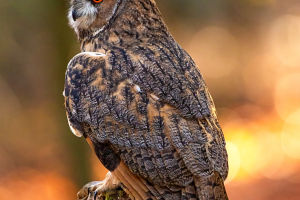Within the expansive embrace of nature lies a mysterious and enchanting creature, celebrated for its distinctive traits and behaviors — the owl.
Owls, revered across diverse cultures as emblems of mystery and wisdom, are not merely symbolic entities but vital contributors to the intricate tapestry of the ecosystem.
Let us embark on a journey to delve deeply into these nocturnal sentinels, unraveling their lifestyle, environmental adaptations, and intricate relationship with humanity.
The Nocturnal Realm of Owls
Owls, classified within the order Strigiformes, predominantly thrive under the cloak of night. Adorned with unique physiognomy, they boast faces reminiscent of felines, earning the moniker 'owl.'
Equipped with exceptional nocturnal vision and acute auditory senses, owls reign supreme as adept night hunters, stealthily preying upon small mammals, insects, and even avian counterparts.
The striking countenance and nocturnal disposition of owls imbue them with a mystique and allure, casting them as protagonists in myriad myths and legends.
These creatures were revered as symbols of sagacity and portents throughout antiquity, albeit carrying ominous connotations in certain cultures. Nevertheless, as humanity's understanding of the natural world deepened, the pivotal role of owls within the ecosystem gradually came to light.
Ecological Significance and Environmental Adaptations
Within the intricate web of life, owls assume a crucial predatory role, regulating populations of small mammals and insects, thereby preserving ecological equilibrium.
Furthermore, serving as sentinel species within ecosystems, their presence is a barometer of environmental health. Consequently, the conservation of owls and their habitats emerges as an imperative for sustaining ecological harmony.
Endowed with remarkable adaptability, owls thrive across diverse habitats ranging from lush forests to arid deserts, verdant grasslands, and bustling urban landscapes.
Their specialized feather structure and silent flight prowess allow them to hunt stealthily across varied terrains. Moreover, their nocturnal proclivity enables them to evade diurnal competitors, ensuring survival amidst the hustle and bustle of daytime predators.
A Complex Relationship with Humanity
While owls have long been associated with ill omens in numerous cultural narratives, modern perceptions have evolved.
Many now revere owls as custodians of wisdom and guardians of the nocturnal realm, with some communities actively advocating for their protection and habitat preservation to uphold ecological balance.
Nonetheless, human activities continue to pose significant threats to owl populations. Deforestation, urban sprawl, and agricultural expansion encroach upon their habitats, while pollution and pesticide usage directly imperil their existence.
Hence, safeguarding owls necessitates concerted human endeavors, encompassing habitat conservation, pollution mitigation, and educational outreach initiatives.
Conclusion: A Call to Action
As the enigmatic guardians of the night, owls captivate the human imagination with their mysterious allure. Beyond their mystical façade, they emerge as indispensable components of the natural order, warranting our utmost protection and stewardship.
Let us unite in solidarity with these majestic creatures, forging a collective resolve to safeguard our shared habitat. Together, hand in wing with owls, let us embark on a journey to preserve and cherish the splendor of our Earth.


